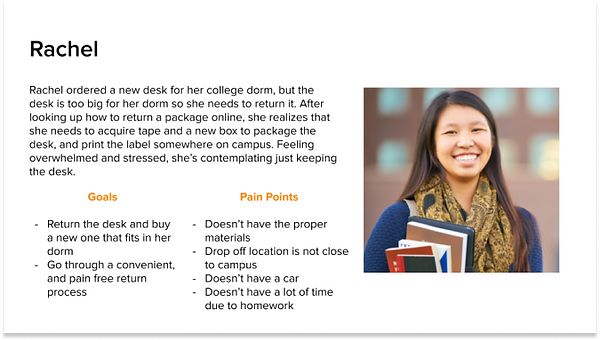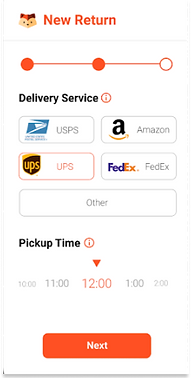top of page
Digital Service Innovation
Box Fox
Year
Fall 2019
Team
Chloe Kim
Steven Moore
Mohona Sengupta
Tasks
Opportunity Framing, Value Creation, Pivoting, User Research, Persona Creation, Story Boarding, Video Sketches, Pitching

How can we use design and technology to simplify the return and package sending process?
Background
Project Description
The goal of this project was to guide an idea for digital service to a minimum viable product. For our project, we made Box Fox, a service that simplifies the package sending process by connecting users to workers in the gig economy willing to box up and return the user’s item. We eventually reached this idea after pivoting away from a service that simplifies the package management system for apartment buildings.
SET Analysis | Value Flow Diagram
Creating a SET Analysis and defining the product opportunity gap helped our team to evaluate existing challenges in developing Box Fox from an idea to a real business model. Overall, the SET Analysis showed us that there was value for Box Fox in the current market.
Creating a value flow enabled our team to easily visualize the existing holes or extra steps that may be present in our service idea. It also helped us keep in mind the different stakeholders, so that we can ensure everyone is accounted for in the final design of our service.

Initial Research
Background Research
Our team first looked at technology hurdles specifically around computer vision We believed that computer vision would be the future in this space because information about packages, such as the tracking number, recipient, and apartment number, can be processed with just a snap of the photo. We found that computer vision solutions are already present, but provide a frustrating user experience as the lighting conditions need to be ideal in order for it to work.
We also took this opportunity to get some statistics confirming that this is a growing problem space. We found that:
NPR/Marist Poll
76% of US consumers shop online
CNBC
The demand for apartment rentals are surging
Competitive Analysis
We found 2 competitors that are relevant in our problem space.

Envoy is primarily a corporate visitor and delivery management service, so they differ in that they aren’t focused on apartments and delivery alerts is just a small feature in their overall product.

notifii is a package management and community notification platform, is focused on covering residences, universities, and business, but they offer few features.
We feel like we can differentiate ourselves by offering more features that will specifically alleviate the problem of package management in apartments.
Opportunity Framing
Initial Problem Space
How might we simplify package management for residents and apartment complexes?
Our team wanted to create a service that tackles a problem related to packages and apartments since ecommerce continues to trend upwards, and more people are to choosing to live in an apartment.
We initially settled on creating a service that handles package management in apartment buildings because many apartments have a primitive package management system that requires a lot of manual labor. Additionally, errors in this system directly cause residents to suffer because they do not get their package on time, and are unsure whether their package was either mislabeled, stolen, or lost.
User Interviews
Goals
We interviewed 5 landlords, 10 employees, and 17 residents. We specifically designed our interview questions to answer the following questions.
1. Do people believe package management is a problem?
2. Will people be willing to adopt our service
3. Who is the target audience that would see value in our service
4. What will be their main purpose for using it?
Interview Findings

Landlords constantly have to deal with a missing or stolen package problem, however, they mainly attribute that problem to human theft. They also don’t view package management as an essential problem, so they are unmotivated to spend money to upgrade their current solution.
Employees loved our idea! The consensus opinion was that package management is the most tedious part of their job, and that Box Fox would make package management more efficient


There was an unanimous belief among residents we interviewed that the service will be useful, but won't really improve the quality of their life that much. A majority of residents have not had a package lost or stolen, and cited returning packages as a much larger issue.
Pivot
New Problem Space
How can we simplify the return and package sending process?
After pivoting away from apartment package management, our team wanted to create a service that makes the package sending process simpler and more convenient.
Reasons for Pivoting
We believe that this is a bigger problem space because our research revealed that not everyone knows how to return or send packages, and most people view returning or sending packages as a painful and inconvenient process. Additionally, pivoting to this problem space allows us to reach more people we can now create a service that is not limited to people that live in an apartment.
Additionally, interviewing peopled helped us understand that they thought that returning packages is a more painful and common problem compared to managing packages in apartments.
Research: Round 2
Numbers Don't Lie
When our team conducted research on our new problem space, we found statistics that confirmed how big and unaddressed the problem of sending packages really is!
2 in 5 US consumers
receive 1 - 2 Amazon packages per week
Three $40 unwanted items per year
are kept on average by millenials
Returns are a hassle
The leading reason a majority of online shoppers kept purchases
User Interviews
We interviewed 32 people who returned a package in the past 6 months to help us discover some common pain points and goals. Through this research, we found three themes that kept coming up in the participant responses. As a result, we identified the following three pain points:

Acquiring Package Materials

Accessing Drop Off Facilities

Finding the Time
Personas
Our personas were created from our user interviews. In this specific scenario, personas helped in deciding the direction our design went to, as our team would consider the needs of each persona and figure out which direction would fulfill the most needs.

Design Work
Early Wireframes
These early wireframes are meant to clarify how Box Fox works by showing the features that we wanted to provide as part of the MVP. This is just an early version of what the interfaces might look like, and I want to revisit this project to make higher fidelity wireframes of the app!



Concept Video
Our goal for this concept video was to show the value of Box Fox by having a student struggle to return a heavy package, and eventually turn to Box Fox to deal with it. We purposely used humor, a relatable character, and a quick narrative to ensure that our concept video is engaging and properly shows the pain point we solved.

MVP
Features
Box Fox, at its core, allows users to send packages, or return packages conveniently. When a user wants to send a package, Box Fox just requires the user to select the shipping speed, confirm a payment method, and have the item ready. With the information given, Box Fox will prepare an item and the shipping label, and give an approximate time window of when the courier is going to show up to receive the item. The courier will then pick up the item, prepare it for shipping, and drop it off.
When the user wants to return a package, the only step that differs is that the user provides a return label instead of Box Fox creating a shipping label.
Updated Value Flow
Our updated value flow makes it clear how much value Box Fox is co-creating with its users, couriers, and even shipping providers.

Competitive Analysis

We really wanted to build on the need of making return easier, and we believe that Amazon’s partnership with Kohls is not easy enough. To illustrate, when was the last time you have been to Kohls.

There also exists several companies, like Optoro, that deal with return logistics from the company side of things, but we wanted to focus more on giving convenience to the customer.
Ultimately, Box Fox is unique in that our service can work with virtually any shipping company. We also pioneers in bringing the Postmates/Uber model that many customers are already familiar with to the package sending space.
Business Model
Our business model can be summarized in 3 points:
Customers pay a small delivery fee
(Ex: $0.99 - $3.99)
Higher fees for expedited, larger packages, fragile, etc.
Subscription model (Ex: $15 a month) for no delivery fee returns
It’s worth noting that these prices are arbitrary and further research needs to be done before the delivery fees and subscription fee are finalized.
Reflection
Thoughts on Service Design
This was my first service design project, so I was new to the idea of using design to co-create value with the user and the service. I found service design to be more strategic and systematic because I had to consider interactions in more contexts than a computer or a digital device. To illustrate, it was a challenge to decide how users should interact with couriers, as this crucial step could cause our service to lose users if it was too painful or demanding.
Additionally, this was the first time that I needed to think about the fact that this prototype needs to make money to exist, and that definitely informed some of my design decisions.
Ultimately, I believe that service design is a field that is just about to take off. I think that the need for service designers is continuing to grow was we now live in a world where there is no longer a clear distinction between goods and services.
Future Work
Higher Fidelity Prototypes
I really like this project, and I truly believe that a service like Box Fox could be successful in the world today. Thus, the next step that I want to take with this project is to flesh out the wireframes, and iteratively test them with users.
I believe that it will be a great exercise and learning experience to be able to design a service that utilizes the gig economy, as there are arguments that the gig economy is going to be a major force driving the future of employment.
I will update this page with higher fidelity prototypes when I finish them!
bottom of page